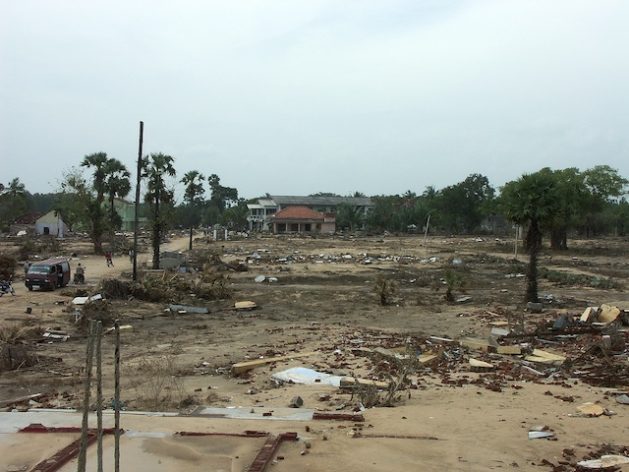Friday, April 19, 2024
News and Views from the Global South
Climate Change
Half World’s Population, Exposed to Floods, Storms, Tsunamis, by 2030

The pulverised beach in Kalmunai, located in eastern Sri Lanka, was stripped of most of its standing structures by the ferocity of the waves. Credit: Amantha Perera/IPS
- While negotiators from all over the world have been discussing, since 31 October 2021 in Glasgow, every single word, coma and dot in order to reach a final text that is expected to apparently keep everyone happy but really not everybody satisfied, 50% of world’s population will live in coastal areas, exposed to floods, storms and tsunamis by the year 2030.
The alarm bell rang during the UN Climate Change Conference (COP26), hosted in Glasgow by the United Kingdom, which is scheduled to end on 12 November with a final accord including a set of promises that, hopefully, will be met… unlike the previous unfulfilled ones.
The alert was sounded on 4 November on the occasion of this year’s World Tsunami Awareness Day.
What are tsunamis?
Volcanic eruptions, submarine landslides, and coastal rock falls can also generate a tsunami, as can a large asteroid impacting the ocean. They originate from a vertical movement of the sea floor with the consequent displacement of water mass.
Tsunami waves often look like walls of water and can attack the shoreline and be dangerous for hours, with waves coming every 5 to 60 minutes.
The first wave may not be the largest, and often it is the 2nd, 3rd, 4th or even later waves that are the biggest. After one wave inundates, or floods inland, it recedes seaward often as far as a person can see, so the seafloor is exposed.
The next wave then rushes ashore within minutes and carries with it many floating debris that were destroyed by previous waves.
What are the causes of tsunamis?
Earthquakes – They can be generated by movements along fault zones associated with plate boundaries.
Most strong earthquakes occur in subduction zones where an ocean plate slides under a continental plate or another younger ocean plate.
All earthquakes do not cause tsunamis. There are four conditions necessary for an earthquake to cause a tsunami:
- The earthquake must occur beneath the ocean or cause material to slide into the ocean.
- The earthquake must be strong, at least magnitude 6.5 on the Richter Scale
- The earthquake must rupture the Earth’s surface and it must occur at shallow depth – less than 70km below the surface of the Earth.
- The earthquake must cause vertical movement of the sea floor (up to several metres).
Landslides – A landslide which occurs along the coast can force large amounts of water into the sea, disturbing the water and generate a tsunami. Underwater landslides can also result in tsunamis when the material loosened by the landslide moves violently, pushing the water in front of it.
Volcanic eruptions – Although relatively infrequent, violent volcanic eruptions also represent impulsive disturbances, which can displace a great volume of water and generate extremely destructive tsunami waves in the immediate source area.
One of the largest and most destructive tsunamis ever recorded was generated in August 26, 1883 after the explosion and collapse of the volcano of Krakatoa, in Indonesia. This explosion generated waves that reached 135 feet (41,15 metres), destroyed coastal towns and villages along the Sunda Strait in both the islands of Java and Sumatra, killing 36,417 people.
Extraterrestrial collisions – Tsunamis caused by extraterrestrial collisions (i.e. asteroids, meteors) are an extremely rare occurrence. Although no meteor/asteroid-induced tsunamis have been recorded in recent history, scientists realize that if these celestial bodies should strike the ocean, a large volume of water would undoubtedly be displaced to cause a tsunami.
Rapid urbanisation and growing tourism in regions prone to tsunamis, are also putting even more people in harm’s way.
Rare but deadly
Tsunamis are rare events but can be extremely deadly.
In the past 100 years, 58 of them have claimed more than 260,000 lives, or an average of 4,600 per disaster – more than any other natural hazard.
The highest number of deaths occurred in the Indian Ocean tsunami of December 2004, which caused an estimated 227,000 fatalities across 14 countries. Indonesia, Sri Lanka, India and Thailand were the hardest hit.
Just three weeks after the disaster, the international community came together in Kobe, Japan, and adopted the 10-year Hyogo Framework for Action, the first comprehensive global agreement on disaster risk reduction.
They also created the Indian Ocean Tsunami Warning and Mitigation System, which uses seismographic and sea-level monitoring stations to send alerts to national tsunami information centres.
In his message marking this year’s World Tsunami Day, the UN Secretary-General called on all countries, international bodies, and civil society, to increase understanding of the deadly threat, and share innovative approaches to reduce risks.
“We can build on progress achieved – ranging from better outreach to tsunami-exposed communities around the world, to the inclusion of a Tsunami Programme in the UN Decade of Ocean Science for Sustainable Development”, António Guterres said. However, he cautioned that the risks “remain immense.”
“Rising sea levels caused by the climate emergency will further exacerbate the destructive power of tsunamis.”
The 2021 World Tsunami Awareness Day was meant to promote the “Sendai Seven Campaign,” specifically the target that looks to enhance international cooperation to developing countries, those who are most at risk.
All this sounds fine. But: are all half of the world population who will be exposed to such deadly threats in just eight years from now, are they aware of the arduous wording exercise among negotiators in Glasgow to formulate a ‘politically correct’ declaration?

 Print
Print



